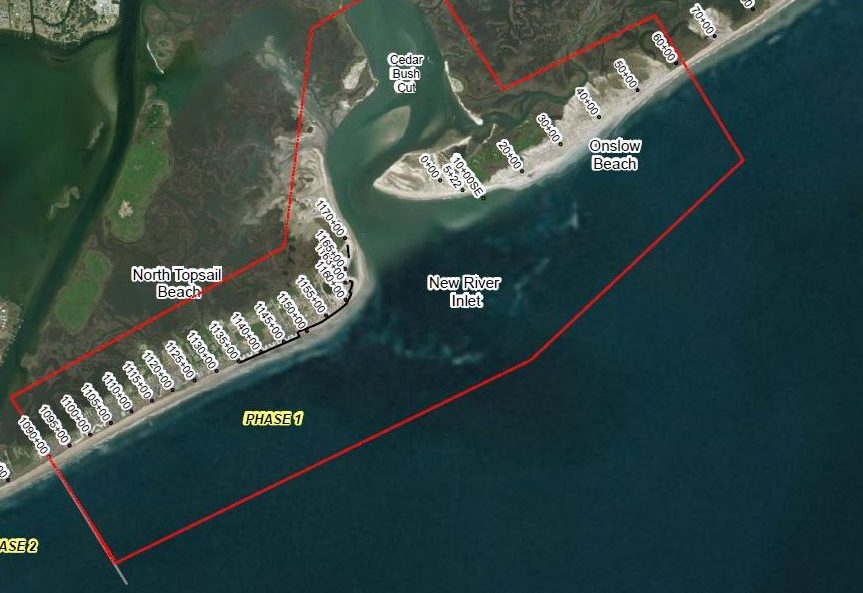
The U.S. Army Corps of Engineers is taking public comments until April 14 on North Topsail Beach’s proposed terminal groin project.
During a scoping meeting last week hosted by the Corps’ Wilmington District, Fran Way, a senior coastal engineer with Applied Technology and Management Inc., or ATM, presented an overview of the town’s proposed New River Inlet Management Master Plan.
Supporter Spotlight
That plan includes the construction of a little more than 2,000-foot-long terminal groin at the north end of the Onslow County town at New River Inlet.
A terminal groin is a wall-like structure made of rock or other material placed perpendicular to the shore and adjacent to an inlet to control erosion.
North Topsail Beach has for years battled severe inlet erosion, which has forced the demolition and relocation of more than a dozen homes at the north end of Topsail Island within the past couple of decades.
Since 2014 the town received an emergency permit to build a sandbag revetment at the northern end of the town’s 11-mile oceanfront shoreline to protect homes and condominiums.
In all about 3,600 feet of sandbags have been placed along the ocean shore from the inlet south to Topsail Reef condominiums, an area where the erosion rate is as high as 100 feet per year, according to information provided by coastal engineers.
Supporter Spotlight

“We want a healthy beach and dune system in this area,” Way said. “These bags have done a really good job so far, but we need a long-term successful management of the area.”
The town in 2009 went through an environmental impact statement, or EIS, process to examine shoreline protection alternatives.
An EIS is a document that examines the positive and negative effects of a proposed project on the environment. Regulatory agencies use these documents, which are created by town-hired firms, as a tool to help determine whether to issue permits and what conditions, such as monitoring, to require in a permit.
The town chose a channel realignment project, one that ultimately “wasn’t as successful as anticipated,” Way said.
“It did not work and the erosion got exacerbated at the north end,” he said.
The latest EIS will include five alternatives, two of which examine construction of terminal groins.
Way said a preferred alternative has not been selected. “We’re still looking at all the other alternatives.”
North Topsail Beach hired Dial Cordy and Associates, a Jacksonville Beach, Florida-based firm with a regional office in Wilmington, to create an EIS for the proposed project.
Mickey Sugg, the Corps’ regulatory chief of the Wilmington Field Office, explained Thursday night that the federal agency is heavily involved in preparing the EIS.
“I will start by saying what is not an EIS document,” he said. “When an EIS is prepared and finalized one thing it is not is a permit decision. When it’s finalized that does not mean that the town or any applicant has permission to move forward with the project.”
Once a draft EIS is released for public review a 45-day public comment period will be opened and a public hearing will be held within that timeframe.
Comments the Corps receives will be included in the final EIS. Once a final EIS is released the town may apply for a permit for the project.
The public gets the opportunity to comment on permit applications.
At the close of the 45-minute meeting, North Topsail Beach Mayor Joann McDermon asked Corps officials to provide to the public a timeline “for us to be tracking towards.”
“The only thing I would stress to everybody is urgency,” she said.
The town has for years been discussing the option of building a terminal groin at its north end, but damage caused by hurricanes in the past couple of years have forced town officials to shift their focus on recovery efforts.
One of the project alternatives includes the construction of a 2,021-foot-long terminal groin consisting of three main sections: an anchor section, upland section and in-water section.
About 310,000 cubic yards of sand would be placed along about 5,100 linear feet of the north end shoreline every four years under this alternative.
These nourishment cycles would be in conjunction with dredging of the outer bar channel realignment/maintenance events the town has been authorized to conduct since May 2011.
About 600,000 cubic yards of material is expected to be dredged from the inlet, leaving 300,000 cubic yards of sand available to placed south of the proposed project area.
The Corps is accepting comments through April 14. Comments may be sent to Jordan Jessop, Wilmington Regulatory Field Office, at Jordan.e.jessop@usace.army.mil.







